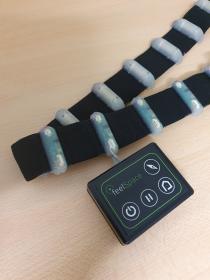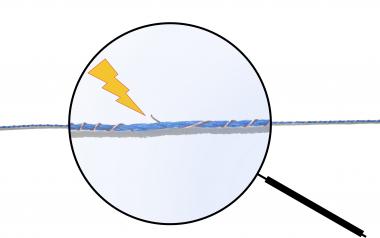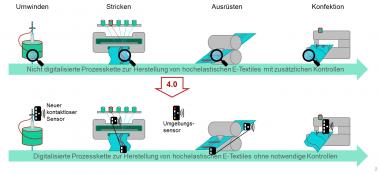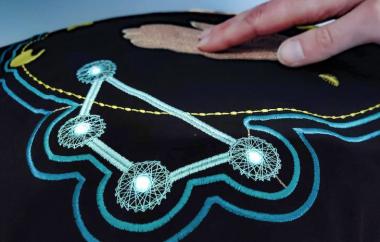E-Textiles: Navigationsgürtel für Sehbehinderte
Vibrationen weisen den Weg: Ein Navigationsgürtel hilft Sehbehinderten, ihr Ziel zu erreichen. Man gibt über eine App die Strecke ein, die man zurücklegen möchte, drückt auf „Start“ und der Gürtel führt wie ein Kompass in die richtige Richtung. Die Deutschen Institute für Textil- und Faserforschung Denkendorf (DITF) haben ein Kontaktierverfahren entwickelt, womit diese Orientierungshilfe - und E-Textiles allgemein -wirtschaftlicher und komfortabler hergestellt werden können.
Wenn man in eine Straße abbiegen muss, vibriert der naviGürtel® der Firma feelSpace. Er signalisiert, in welcher Richtung man steht und hilft so nicht nur draußen, sondern auch in geschlossenen Räumen bei der Orientierung. Dafür sorgen 16 Vibrationselemente, die rings um den Gürtel angeordnet sind. Der Projektpartner AMOHR entwickelte hierzu ein spezielles leitfähiges Band, das einerseits durch seine hohe Elastizität einen angenehmen Tragekomfort bietet und andererseits durch eingearbeitete Versteifungen die Kontaktierung der Vibrationselemente ermöglicht.
Im herkömmlichen Verfahren werden Kontaktierungen gelötet. Das Team um Tobias Hecht hat für die Herstellung von E-Textiles ein Verfahren erschlossen, das bisher bei der Kontaktierung von Mikrochips verwendet wird: das Ultraschallschweißen. Damit können die Kontaktstellen verglichen mit einem Lötverfahren deutlich verkleinert werden, die Kontaktierungen werden punktgenau fixiert. Beim Löten wird das Lötmaterial aufgeschmolzen und die Kontaktstellen werden erhitzt. Das heiße Lot zerfließt, wodurch man einen relativ großflächigen Wärmeeintrag erhält. Durch das Fließen des Lotes entstehen auch abseits der Kontaktstelle ungewollte Versteifungen, die vor allem bei E-Textiles die Funktion beeinträchtigen. Beim Ultraschallschweißen entsteht weniger Hitze, was das Material schont.
Darüber hinaus hat das Ultraschweißen gegenüber dem Lötverfahren Vorteile für Gesundheit und Umwelt. Lötzinn ist mit Flussmittel versetzt, das gesundheitsschädliche Dämpfe erzeugt, die abgesaugt und gefiltert werden müssen.
Das Forschungsprojekt wurde im Rahmen des Zentralen Innovationsprogrammes Mittelstand (ZIM) gefördert.
E-Textiles Deutsche Institute für Textil- und Faserforschung AMOHR feelSpace Ultraschall-Schweissmaschinen
Deutsche Institute für Textil- und Faserforschung













